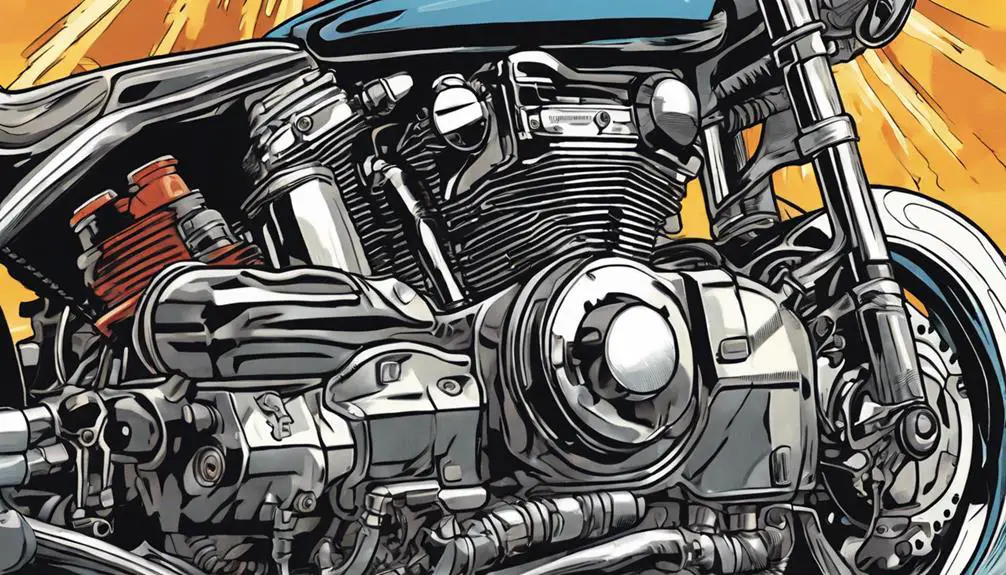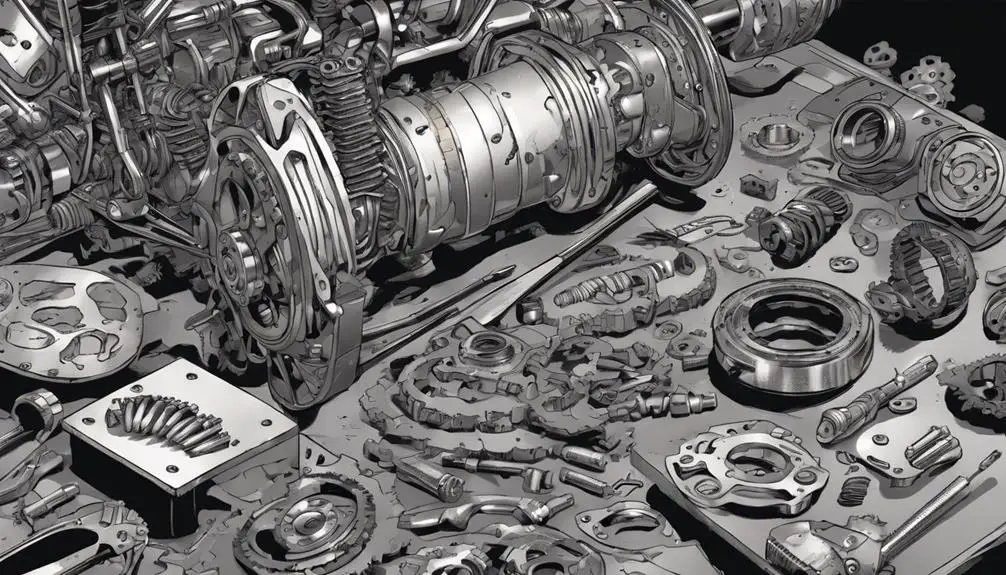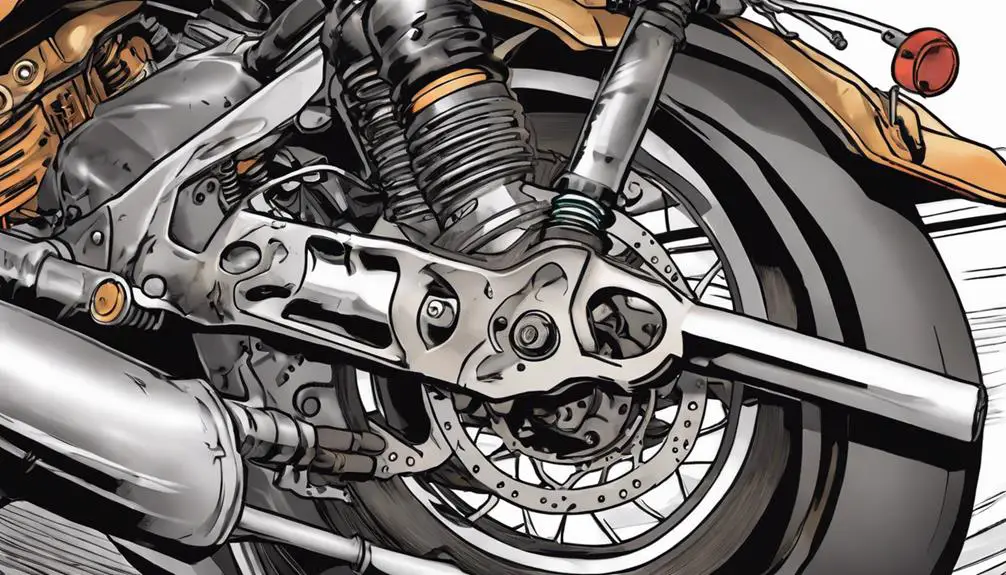When you invest in a popular motorcycle model, it's crucial to know the common issues that could affect your ride. Engine overheating, electrical system failures, and transmission problems are just a few challenges you might encounter. These complications not only impact performance but can also lead to costly repairs if left unchecked. Understanding these concerns can help you stay ahead of the curve, but there's more to the story. What other issues should you be aware of that could influence your motorcycle experience?
Quick Takeaways
- Engine overheating often occurs due to low coolant levels or inadequate cooling systems, impacting popular motorcycle models.
- Electrical system failures frequently arise from corroded connections, faulty batteries, and blown fuses in various motorcycle brands.
- Transmission problems such as slipping gears or difficulty shifting can affect the performance of many popular motorcycle models.
- Fuel system complications, including clogged injectors and fuel leaks, are common issues in well-known motorcycle models.
Engine Overheating Issues

Engine overheating is a common headache for many motorcycle riders, often caused by inadequate cooling systems or low coolant levels. When you're cruising down the open road, the last thing you want is your engine to start sputtering and overheating. You deserve to feel the freedom of the ride, not the frustration of a malfunctioning machine.
To prevent overheating, make it a habit to check your coolant levels regularly. Low coolant can lead to serious engine damage, so keep an eye on it. If your motorcycle has a liquid cooling system, verify the radiator isn't clogged and the hoses are in good shape. Also, remember to pay attention to the ambient temperature and how it affects your bike's performance.
If you notice your temperature gauge rising, pull over and give your engine a break. Let it cool down before you continue your journey. Riding shouldn't feel like a chore, and maintaining your bike can help liberate you from the stress of overheating issues.
Electrical System Failures
Electrical system failures can leave you stranded, making it essential to understand the common issues that can arise with your motorcycle's wiring and components. You want to ride freely, so knowing these problems will help you maintain your bike's electrical integrity.
Here are some common electrical issues you might encounter:
- Battery Drain: A faulty battery or parasitic drain can prevent your bike from starting.
- Corroded Connections: Rust and corrosion on terminals can disrupt power flow, leading to unreliable performance.
- Blown Fuses: Overloaded circuits can cause fuses to blow, cutting off power to essential systems.
- Faulty Regulator/Rectifier: If this component fails, it can lead to overcharging or undercharging, affecting battery life.
Transmission Problems

Transmission problems can seriously affect your riding experience, making it essential to recognize the signs before they escalate. If you notice your bike struggling to shift gears or hearing unusual grinding noises, it's a clear indication that something's off. Ignoring these signs can lead to more significant issues down the line, potentially leaving you stranded on the open road.
You might also experience slipping gears while riding. This can feel like a loss of power, which can be alarming when you're craving that exhilarating freedom. Check your clutch; if it feels loose or unresponsive, you may need to make adjustments or replacements.
Sometimes, fluid leaks can point to underlying transmission troubles. Keep an eye on the ground where you park, as any puddles can be a warning sign that shouldn't be ignored.
Fuel System Complications
Fuel system complications can lead to poor performance and frustrating rides, so it's vital to stay alert for any signs of trouble.
Whether you're cruising down the highway or taking a sharp turn, your bike's fuel system plays an important role in delivering the power you crave. If you notice any of the following issues, it may be time to dig deeper:
- Inconsistent acceleration: If your bike hesitates or stumbles, the fuel delivery might be compromised.
- Rough idling: A shaky engine can indicate clogged injectors or a dirty fuel filter.
- Poor fuel economy: If you're filling up more often than usual, something's off in the fuel system.
- Fuel leaks: Watch for any visible signs of leaking fuel, which can pose a serious safety hazard.
Being aware of these complications empowers you to take action before they escalate.
Regular maintenance and inspections are key to ensuring your fuel system remains in top shape, allowing you to ride freely and confidently.
Suspension and Handling Concerns

Your motorcycle's suspension system plays an essential role in how well it handles various road conditions, affecting your overall riding experience. If your bike bounces excessively or feels unstable, it could be a sign that your suspension needs attention. When you're carving through winding roads or cruising on the open highway, a well-tuned suspension can make all the difference in how liberated you feel.
Common issues with suspension include worn-out shocks or fork seals, which can lead to reduced control and comfort. If you notice your bike diving too much during braking or struggling to absorb bumps, it's time to inspect those components.
Adjusting preload settings can also help tailor the ride to your weight and riding style, enhancing your connection to the road.
Don't overlook tire pressure either; it directly impacts handling. Incorrect pressure can lead to uneven wear and compromised grip.
To experience the freedom of the ride fully, ascertain your suspension is set up right. By addressing these concerns, you not only improve safety but also elevate your enjoyment as you explore the open road.
Ride free, and let your motorcycle's suspension work for you!
Common Questions
What Are the Best Maintenance Tips for Popular Motorcycle Models?
To keep your motorcycle running smoothly, you should check the oil regularly and change it according to the manufacturer's schedule.
Inspect the tires for wear and maintain proper pressure.
Clean and lubricate the chain frequently, and don't forget to check the brakes and lights.
Regularly washing your bike can prevent corrosion.
Finally, keep an eye on the battery, ensuring it's charged and clean.
This way, you'll enjoy the freedom of the open road worry-free!
How Can I Improve My Motorcycle's Fuel Efficiency?
You can skyrocket your motorcycle's fuel efficiency with a few simple tweaks!
Start by keeping your tires properly inflated, as low pressure can drain your tank faster than a thirsty rider.
Regularly clean or replace your air filter, and don't underestimate the power of smooth acceleration.
Lighten your load by removing unnecessary gear, and consider using high-quality fuel.
With these steps, you'll be cruising further with every drop of gas!
What Are Common Tire Wear Patterns to Watch For?
When you're checking your motorcycle tires, look out for common wear patterns like uneven tread, cupping, or bald spots.
These signs can indicate problems with alignment, inflation, or riding style.
If you notice excessive wear on one side, it might mean your bike's not aligned properly.
Keeping an eye on these patterns not only boosts your bike's performance but also helps guarantee your safety on the open road.
Stay aware and ride free!
How Do I Know When to Replace My Motorcycle's Battery?
If you notice your motorcycle struggling to start, like when you turn the key and it just clicks, it's time to check your battery.
You should also watch for dimming lights or a slow-cranking engine.
Most batteries last about three to five years, so if yours is approaching that age, consider replacing it.
Trust your instincts; a reliable battery means more freedom on the road without unexpected stops.
What Safety Gear Is Recommended for Motorcycle Riders?
When you hit the open road, safety gear is essential for your ride.
You should wear a DOT-approved helmet to protect your head, along with a durable jacket made from leather or textile.
Don't forget gloves for grip and protection, and sturdy, abrasion-resistant pants.
Boots with ankle support are vital too.
These items not only keep you safe but also enhance your freedom as you navigate the wind and the thrill of the ride.
Wrapping Up
In the world of motorcycles, it's funny how the same issues can pop up across different models. You'd think with all the advancements, overheating or electrical failures wouldn't be a thing.
Yet, as you ride, you might just find yourself dealing with these common quirks. By staying alert and proactive, you can keep your bike running smoothly and enjoy the ride.
After all, it's the little things that often make the biggest difference on the road.